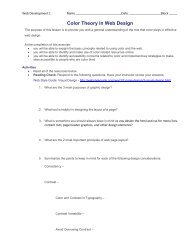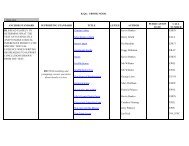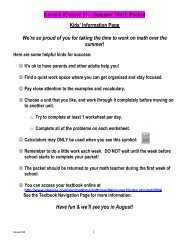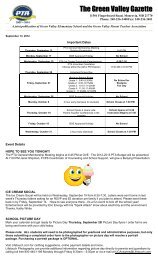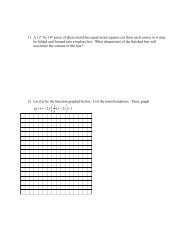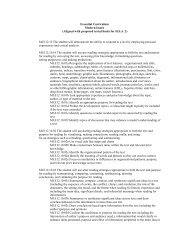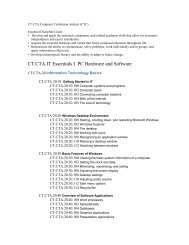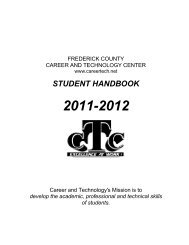always changing® and growing up - P&G School Programs
always changing® and growing up - P&G School Programs
always changing® and growing up - P&G School Programs
You also want an ePaper? Increase the reach of your titles
YUMPU automatically turns print PDFs into web optimized ePapers that Google loves.
<strong>always</strong> changing ® <strong>and</strong> <strong>growing</strong> <strong>up</strong> ®<br />
girl’s guide
Contents<br />
Puberty 1<br />
Body Growth 7<br />
Breast Growth 8<br />
Skin Changes 10<br />
Hair Changes 11<br />
Perspiration 12<br />
Vaginal Discharge 14<br />
Your Period 15<br />
Feminine Protection 23<br />
Always ® Products 30<br />
Glossary 32<br />
All the words in bold type<br />
in this booklet are defined<br />
in the glossary.<br />
Puberty. Yeah, it’s a weird word,<br />
but it doesn’t make you weird.<br />
Puberty is a series of changes that your body – <strong>and</strong> all<br />
your friends’ bodies – will go through as you grow <strong>up</strong>.<br />
Like the word, puberty may seem strange because it’s<br />
new to you. But the more you know about it, the more<br />
comfortable it will be. This guide will help with that by:<br />
Letting you know what changes to expect <strong>and</strong> helping<br />
you underst<strong>and</strong> them.<br />
Helping you prepare for what’s ahead so you can<br />
feel more confident.<br />
Giving you helpful tips <strong>and</strong> answers to many girl questions.<br />
It also helps to talk about puberty. It may seem<br />
embarrassing – that’s normal – but it will help you feel<br />
more relaxed <strong>and</strong> confident. Here are some tips:<br />
Ask someone like your mom or older sister to answer<br />
your questions. They’ve “been there, done that,” so<br />
their experience may help.<br />
If it’s hard to ask your question face-to-face, leave<br />
it in a note.<br />
Visit beinggirl.com, a site just for girls, where you can<br />
learn <strong>and</strong> talk with other girls about <strong>growing</strong> <strong>up</strong> – like<br />
how your body <strong>and</strong> feelings change.<br />
Puberty<br />
Puberty<br />
1
It’s not summer vacation,<br />
but it is a great journey.<br />
During puberty you’ll experience changes to your body,<br />
skin, hair – even your emotions. It may seem like a wild<br />
ride sometimes. But chances are you’ll be happy with the<br />
outcome – the same “you,” just a more grown-<strong>up</strong> version.<br />
Where it all begins.<br />
Your pituitary gl<strong>and</strong>, located beneath the front of your<br />
brain, starts puberty. Your pituitary gl<strong>and</strong> sends a signal<br />
to two other gl<strong>and</strong>s – your ovaries – telling them to<br />
make a special chemical, or hormone, called estrogen.<br />
Estrogen is the main female hormone that triggers most<br />
of the changes you’ll see <strong>and</strong> feel. Boys have a different<br />
hormone, testosterone, that causes most of their<br />
changes.<br />
Puberty<br />
2 ®<br />
Are we there yet? Are we there yet?<br />
Puberty usually starts between the ages of 8 <strong>and</strong> 13 <strong>and</strong><br />
lasts a few years. But every girl is different. Some girls’<br />
pituitary gl<strong>and</strong>s are eager, some take their time. The<br />
important thing is that your pituitary gl<strong>and</strong> will start your<br />
puberty when it’s right for your body. But if you haven’t<br />
experienced any puberty changes by age 14, you may<br />
want to talk to your doctor.<br />
The puberty event girls<br />
want to know about most.<br />
Period.<br />
Your period is the biggest change you’ll<br />
experience. “What’s a period?” “When<br />
do you get it?” “What do you do about<br />
it?” These questions <strong>and</strong> more are<br />
answered on pages 15 to 33.<br />
Puberty<br />
3
4<br />
What you’ll see along the way.<br />
Here’s a quick rundown of the main physical changes<br />
you’ll go through.<br />
You’ll find more info about these throughout this guide.<br />
Your body grows taller <strong>and</strong> broader.<br />
Your breasts begin to grow.<br />
Your skin may become oilier, <strong>and</strong> you may get pimples.<br />
Your hair may become oilier.<br />
Your body may sweat more, <strong>and</strong> you may develop<br />
body odor.<br />
You begin to grow underarm <strong>and</strong> pubic hair.<br />
Vaginal discharge begins.<br />
Your period starts.<br />
Puberty<br />
®<br />
It’s OK.<br />
All these changes won’t<br />
happen overnight. Some<br />
may be quick, but others will<br />
take place slowly over a<br />
few years.<br />
What you’ll feel along the way.<br />
The emotional changes you’ll experience during puberty<br />
may not happen at the same time your body matures.<br />
You could feel older before you look older, or the other<br />
way around. In any case, here are some things to expect:<br />
You’ll start to think more like an adult does.<br />
You’ll begin to make more sense of your feelings –<br />
both positive <strong>and</strong> negative ones – <strong>and</strong><br />
express them better.<br />
You may get angry a lot<br />
easier <strong>and</strong> go through<br />
mood swings. Plus, you<br />
may cry more – over little<br />
<strong>and</strong> big things.<br />
You may become more<br />
self-conscious.<br />
You may compare yourself<br />
to your friends <strong>and</strong> feel like<br />
something is wrong with<br />
you. But there’s not!<br />
You may feel <strong>and</strong> act<br />
more feminine.<br />
Puberty<br />
5
6<br />
Take some time to shine <strong>up</strong> your self-image.<br />
A healthy body image depends on a healthy attitude –<br />
<strong>and</strong> that’s something you can control. Just remember,<br />
the impossibly perfect bodies you see on TV <strong>and</strong> in<br />
magazines are not what most girls <strong>and</strong> women look like,<br />
or should look like.<br />
Feeling good about your body is a great start to boosting<br />
your overall self-esteem. Here are some other ways:<br />
1. Find something you do well, like a sport, an art or a<br />
school subject, <strong>and</strong> focus on succeeding at it.<br />
2. Instead of comparing yourself to others, each day<br />
write down three things about yourself that you<br />
wouldn’t change.<br />
3. Concentrate on your abilities, skills <strong>and</strong><br />
accomplishments instead of your faults.<br />
4. Set expectations that are realistic. Aim for<br />
accomplishment, not perfection.<br />
5. Do a good deed. Making a difference will help you<br />
feel like a better person.<br />
6. Exercise. You’ll unload stress <strong>and</strong> feel stronger<br />
<strong>and</strong> happier.<br />
Puberty<br />
®<br />
Things will begin to shape<br />
<strong>up</strong> for you.<br />
Body Growth<br />
You know puberty has kicked in when you grow taller <strong>and</strong><br />
begin to take on a more feminine shape. Your hips will<br />
widen <strong>and</strong> your breasts will begin to grow. Until you get<br />
used to your new shape <strong>and</strong> size, you may feel awkward.<br />
And naturally, you may gain weight. In fact, many girls<br />
are a little larger than boys in the early years of puberty.<br />
All girls, as they grow <strong>up</strong>, develop more body fat. As long<br />
as you eat well <strong>and</strong> exercise, your weight should stay in a<br />
healthy range.<br />
Eat well <strong>and</strong> feel well –<br />
inside <strong>and</strong> out.<br />
Eat a range of foods to get all<br />
the vitamins <strong>and</strong> nutrients you<br />
need. Try to eat lots of protein<br />
(like fish, meat, cheese, milk,<br />
eggs <strong>and</strong> beans). You also need<br />
complex carbohydrates (like<br />
whole wheat breads, pasta<br />
<strong>and</strong> cereals) <strong>and</strong> fresh fruits<br />
<strong>and</strong> vegetables.<br />
Body Growth<br />
7
Breast Growth<br />
8<br />
Starting from the top.<br />
During early puberty, the first stage of breast development<br />
happens, called “budding.” From there, your breasts grow<br />
gradually – you probably won’t notice it most of the time.<br />
One breast may grow larger than the other – that’s okay.<br />
They’ll be about the same size in the end. But like your<br />
legs <strong>and</strong> arms, your breasts will never be exactly alike –<br />
no one’s are.<br />
Breasts <strong>and</strong> bras – both come in lots of<br />
shapes <strong>and</strong> sizes.<br />
Once your breasts develop, wearing a bra provides<br />
s<strong>up</strong>port <strong>and</strong> coverage that can help you feel more<br />
comfortable. Plus, bras come in tons of fun colors<br />
<strong>and</strong> designs so you can find ones that match your<br />
personal style.<br />
Just make sure<br />
it fits you<br />
properly.<br />
Breast Growth<br />
®<br />
The scoop on bra sizing.<br />
Many stores that sell bras have experts who can tell your<br />
correct size by measuring you. Or, you can have a friend<br />
or trusted adult measure you using the following guide:<br />
1. Measure around your chest just below your breasts.<br />
2. If it’s an odd number, add 5.<br />
If it’s an even number, add 4.<br />
This is your frame size.<br />
3. Now find your bust line size<br />
by measuring around your<br />
chest over the fullest part<br />
of your breasts.<br />
4. Compare your frame size <strong>and</strong> bust<br />
line size to determine your c<strong>up</strong> size:<br />
If they are the same,<br />
you need an AA-c<strong>up</strong>.<br />
If they differ by 1, you need an A-c<strong>up</strong>.<br />
If they differ by 2, you need a B-c<strong>up</strong>.<br />
If they differ by 3, you need a C-c<strong>up</strong>.<br />
If they differ by 4, you need a D-c<strong>up</strong>.<br />
5. Your bra size is your frame <strong>and</strong> c<strong>up</strong> sizes together.<br />
Breast Growth<br />
9
Skin Changes Hair Changes<br />
10<br />
The skinny on your skin.<br />
During puberty, your oil gl<strong>and</strong>s produce more sebum<br />
(an oily substance). Sometimes extra sebum <strong>and</strong><br />
dead skin cells clog your skin’s pores. When bacteria grow<br />
in the clogged pores it causes pimples (acne).<br />
Acne is very common – 90% of young people get it. You<br />
can keep it under control, though, most of the time with<br />
a daily routine of skin care. Just remember to be patient.<br />
Acne doesn’t disappear overnight – for anyone.<br />
Good habits for healthy skin.<br />
Wash your face twice a day with a cleanser or<br />
medicated acne wash.<br />
Keep your h<strong>and</strong>s away from your face <strong>and</strong> don’t<br />
squeeze, pick or pop pimples.<br />
Take a daily multivitamin, eat plenty of fruits <strong>and</strong><br />
vegetables, <strong>and</strong> drink lots of water.<br />
Wash your pillowcase frequently to get rid of oil <strong>and</strong><br />
dirt build-<strong>up</strong>.<br />
When you’re in the sun, wear sunscreen or block with<br />
at least an SPF (sun protection factor) of 15.<br />
Skin Changes<br />
®<br />
Heads <strong>up</strong>!<br />
Your hair may need more attention.<br />
Puberty may cause your hair to become oilier, thicker,<br />
coarser – even curlier or straighter. The important thing is<br />
to keep it healthy with regular care.<br />
Good habits for healthy hair.<br />
Shampoo regularly (daily or every other day is best<br />
for most hair types).<br />
If you’re African-American, your hair may be dry <strong>and</strong><br />
delicate. So you only need to wash your hair 1 to 2<br />
times a week.<br />
After shampooing, use a light conditioner<br />
to add moisture, control <strong>and</strong> strength.<br />
When you’re swimming or in<br />
the sun, use an intensive<br />
conditioner with UV<br />
protection.<br />
When your hair is wet, use<br />
a wide-tooth comb. A brush<br />
may break your hair str<strong>and</strong>s.<br />
Got a<br />
question?<br />
For answers to<br />
your hair <strong>and</strong> skin<br />
care questions,<br />
visit beinggirl.com.<br />
Hair Changes<br />
11
Perspiration<br />
12<br />
Sweating is good for you.<br />
So why the big stink about it?<br />
Everybody sweats, or perspires. It’s a normal <strong>and</strong><br />
important function – it helps regulate your body<br />
temperature. But once you hit puberty, sweating can also<br />
cause body odor.<br />
Epidermis<br />
Dermis<br />
Subcutaneous<br />
Tissue<br />
Perspiration<br />
Pores<br />
Hair Shaft<br />
Sebaceous Gl<strong>and</strong><br />
Eccrine Gl<strong>and</strong><br />
Apocrine Gl<strong>and</strong><br />
Body odor is triggered<br />
by your apocrine gl<strong>and</strong>s<br />
– the kind of sweat<br />
gl<strong>and</strong>s that kick in at<br />
puberty. Your other<br />
sweat gl<strong>and</strong>s – eccrine gl<strong>and</strong>s – start working at birth.<br />
Eccrine gl<strong>and</strong>s produce clear, odorless perspiration,<br />
but apocrine gl<strong>and</strong>s produce perspiration that can smell<br />
bad when it comes in contact with bacteria on your skin.<br />
Since a lot of apocrine gl<strong>and</strong>s are under your arms,<br />
many people use underarm deodorants or antiperspirants.<br />
Deodorants counteract odor to help you smell better.<br />
Antiperspirants reduce sweating <strong>and</strong> underarm wetness.<br />
Since these are the main causes of bodyodor,<br />
anti-perspirants help prevent odor before it starts.<br />
®<br />
Body odor busters.<br />
Shower or bathe frequently to wash dirt <strong>and</strong> oil off your skin.<br />
Make sure to wash your underarms thoroughly.<br />
Apply deodorant/antiperspirant at least once a day.<br />
Wear clothes made of material that breathes, like cotton.<br />
Always shower or<br />
bathe after you<br />
exercise. If you can’t<br />
do it right away, at<br />
least change out of<br />
your sweaty clothes<br />
<strong>and</strong> into clean ones.<br />
When you’re ready<br />
for deodora nt.<br />
There are many types<br />
of antiperspirants/<br />
deodorants. What kind<br />
you need or want depends<br />
on you. How much you sweat<br />
Did you know?<br />
Sweat gl<strong>and</strong>s are<br />
everywhere on your body<br />
except your lips <strong>and</strong> ears.<br />
Females have a lot more<br />
apocrine gl<strong>and</strong>s than males.<br />
Females <strong>and</strong> males<br />
sweat differently. So their<br />
deodorants <strong>and</strong> antiperspirants<br />
are different,<br />
too. For the best protection,<br />
pick one that’s made<br />
for girls <strong>and</strong> women.<br />
(we’re all different), whether you like a more noticeable<br />
scent (or not), <strong>and</strong> even how the product feels can all help<br />
you figure out which type is best for you.<br />
Perspiration<br />
13
Vaginal Discharge<br />
14<br />
Vaginal discharge – a sign<br />
that your period is on its way.<br />
Vaginal discharge is a clear or whitish fluid that comes from<br />
your vagina (an opening between your legs). This type of<br />
discharge is healthy <strong>and</strong> normal. It keeps the vagina from<br />
drying out <strong>and</strong> helps prevent infection. When you notice it<br />
in your underwear (a creamy white stain) for the first time,<br />
it usually means your first period is coming soon. To avoid<br />
getting discharge in your underwear between periods, you<br />
can wear a pantiliner (for more info, see pages 26, 27 <strong>and</strong> 30).<br />
If you have any discharge that is thick, yellowish or darker,<br />
smells unpleasant or causes itching or burning, it could<br />
be a sign of a vaginal infection. Check with your doctor.<br />
Most vaginal infections can be easily treated.<br />
Good feminine hygiene can help<br />
protect you from infections:<br />
After going to the bathroom, wipe from front to back to<br />
avoid spreading bacteria from your anus to your vagina.<br />
Avoid heavily perfumed soaps or shower gels – these can<br />
sometimes irritate the delicate skin around your vagina.<br />
Remember, if you’re taking antibiotics, vaginal<br />
infections are more likely to occur.<br />
Vaginal Discharge<br />
®<br />
Your period. Celebrate it<br />
with an exclamation point!<br />
Getting your period is probably the biggest change you’ll<br />
experience during puberty. It’s a very normal, healthy <strong>and</strong><br />
positive part of <strong>growing</strong> <strong>up</strong>! It’s part of a natural cycle<br />
(the menstrual cycle) that prepares the body’s ability to<br />
have children.<br />
A quick definition.<br />
Your period is when you shed tissue, fluid <strong>and</strong> blood from<br />
your uterine lining (also called menstrual discharge). It<br />
leaves your body through your vagina. For most girls <strong>and</strong><br />
women, it usually happens each month <strong>and</strong> lasts between<br />
3 <strong>and</strong> 7 days. It may come as a surprise when you get<br />
your first one – that’s okay, it happens to a lot of girls.<br />
The whole story.<br />
The complete explanation may sound like a science<br />
lesson. But underst<strong>and</strong>ing the menstrual cycle will help<br />
take the mystery out of your period. It will also help you<br />
predict when your period will come each month once<br />
your cycle starts.<br />
Your Period<br />
Your Period<br />
15
16<br />
The phases of the menstrual cycle.<br />
1. Pre-Ovulation. Females have two ovaries that contain<br />
thous<strong>and</strong>s of eggs (ova). Estrogen tells an ovary to<br />
release an egg every month. (One ovary releases an egg<br />
each month.) At the same time, the soft lining<br />
(endometrium) of the uterus (the place where<br />
a baby can grow) starts to thicken.<br />
2. Ovulation. Ovulation occurs when a mature<br />
egg is released from the ovary. After the egg<br />
is released it travels along the fallopian<br />
tube to the thickening endometrium. If a<br />
sperm (the male reproductive cell)<br />
fertilizes the egg, a baby develops.<br />
3. Premenstrual. If the egg isn’t fertilized,<br />
it breaks down <strong>and</strong> the endometrium<br />
isn’t needed. As a result, hormone levels<br />
drop causing the endometrium to shed.<br />
4. Menstruation. The<br />
endometrium leaves<br />
the body through the<br />
vagina as a reddish<br />
fluidcontainingblood.<br />
This is a period.<br />
Your Period<br />
®<br />
Endometrium<br />
Eggs<br />
Uterus<br />
Fallopian<br />
Tube<br />
Ovary<br />
Vagina<br />
Position<br />
inside body<br />
The cycle repeats itself.<br />
A complete menstrual cycle runs from the first<br />
day of one period to the first day of the next.<br />
The average time this takes is 28 days, but anywhere<br />
between 21 <strong>and</strong> 35 days is normal. Then the cycle<br />
starts again.<br />
1<br />
An ovary gets ready<br />
to release an egg.<br />
4<br />
The endometrium<br />
is not needed <strong>and</strong><br />
most of it is shed<br />
through the vagina.<br />
2<br />
The egg is released.<br />
The endometrium<br />
starts to thicken.<br />
3<br />
The egg travels<br />
along the fallopian<br />
tube to the thickening<br />
endometrium.<br />
Your Period<br />
17
18<br />
Getting into a groove.<br />
It’s a good idea to get to know your cycle right from the<br />
start. Many girls <strong>and</strong> women prepare for their next period<br />
by tracking their cycle on a calendar. You can use your<br />
own calendar or the one online at http://www.beinggirl.<br />
com/article/period-predictor/.<br />
Your Period<br />
sun mon tue wed thu fri sat<br />
1 2 3 4 5 6 7<br />
8 9 10 11 12 13 14<br />
15<br />
22<br />
29<br />
Each month, mark the days that you have your period. As<br />
your cycle evens out, you’ll begin to see a regular pattern.<br />
By figuring the average number of days between your<br />
periods, you’ll be able to tell when the next one will most<br />
likely start. You can also record how you feel on your preperiod<br />
days. These feelings may be future “hints” that<br />
your period is coming.<br />
®<br />
16<br />
23<br />
30<br />
17<br />
24<br />
31<br />
18<br />
25<br />
19<br />
26<br />
Mood Changes Light Period Day<br />
20<br />
27<br />
21<br />
28<br />
Heavy Period Day<br />
When will your period start?<br />
Most girls get their first period between the ages of 9 <strong>and</strong><br />
16, but there is no “right” time. Your period will start when<br />
your body is ready. If you haven’t started by the time<br />
you’re 16, you may want to talk to your doctor.<br />
As a rough guide, your period will probably start:<br />
About two years after your breasts begin to develop.<br />
Within a year or so after you’ve developed<br />
pubic <strong>and</strong> underarm hair.<br />
After you start to notice some<br />
vaginal discharge in your undies.<br />
Being irregular is a<br />
regular thing.<br />
In the beginning, your period may be<br />
irregular. You could have one period<br />
<strong>and</strong> then wait as long as 6 months<br />
for the next one! Or, one period may<br />
last one day, while the next lasts 10<br />
days. This happens to a lot of girls.<br />
Oftentimes, it takes a while before a<br />
girl’s body settles into a regular cycle.<br />
In fact, it may take <strong>up</strong> to 2 or 3 years.<br />
Your Period<br />
19
20<br />
Some popular questions about your period.<br />
Is it okay to take a bath or shower when you have<br />
your period?<br />
Yes. During your period is an important time to keep<br />
yourself fresh <strong>and</strong> clean.<br />
Is there anything you won’t be able to do when you<br />
have your period?<br />
No. It doesn’t have to stop you from doing the things<br />
you usually do. You can still go to school, help at<br />
home, see your friends, play sports <strong>and</strong> so on.<br />
Will anyone notice when you have your period?<br />
No. Not unless you tell them.<br />
How much blood do you lose during your period?<br />
The average female loses about 4 to 12 teaspoons of<br />
menstrual fluid during her period. But only a small<br />
amount of that is blood. Since your body contains<br />
more than 5 quarts of blood, it doesn’t miss the little<br />
bit lost during a period – <strong>and</strong> your body makes <strong>up</strong> for<br />
it quickly.<br />
Your Period<br />
®<br />
Sometimes your period brings uninvited<br />
guests – cramps.<br />
A lot of girls <strong>and</strong> women experience “period cramps”<br />
caused by the contraction of the uterus. If you get<br />
cramps, you may feel aches in your abdomen, your lower<br />
back or even down your legs.<br />
Ways to put cramps in their place.<br />
Take a warm bath, unwind <strong>and</strong> listen to some tunes.<br />
Place a heating pad or heat wrap on your abdomen.<br />
Then kick back, relax <strong>and</strong> read a magazine or watch TV.<br />
Do some mild exercise that<br />
you enjoy, like walking your<br />
dog or riding your bike with a<br />
friend.<br />
If cramps continue to be a problem<br />
for you, make sure you check with<br />
an adult before taking any kind of<br />
medication.<br />
Your Period<br />
21
22<br />
What is Premenstrual Syndrome (PMS)?<br />
PMS refers to the symptoms that some girls <strong>and</strong> women<br />
experience 1 to 14 days before their period. These symptoms<br />
are caused by changing hormone levels <strong>and</strong> may include<br />
headaches, backaches, food cravings, depression, moodiness,<br />
breast tenderness, pain in the joints, general tiredness, <strong>and</strong><br />
weight gain or a bloated feeling. Skin blemishes may also flare <strong>up</strong>.<br />
Here are a few things you can do to help relieve PMS:<br />
Exercise regularly.<br />
Limit drinking caffeinated drinks like colas.<br />
Avoid salt.<br />
Ask your doctor for remedies.<br />
Check with a trusted adult to see if you can take an<br />
over-the-counter medication.<br />
Your Period<br />
®<br />
Feminine Protection<br />
What to use during your period.<br />
Feminine protection refers to the products girls <strong>and</strong><br />
women use to absorb their menstrual flow or to stay<br />
feeling fresh, comfortable <strong>and</strong> confident every day.<br />
There are three types of feminine protection:<br />
(You’ll find more details about these on pages 24 to 31.)<br />
Pads.<br />
Pantiliners.<br />
Tampons.<br />
Where to buy them.<br />
You can buy pantiliners,<br />
pads or tampons in many<br />
places like s<strong>up</strong>ermarkets,<br />
pharmacies <strong>and</strong> discount<br />
stores. If you feel a little<br />
funny about buying them<br />
at first, just ask someone<br />
like your mom or older<br />
sister to make the purchase<br />
for you.<br />
What is right<br />
for you?<br />
Some girls <strong>and</strong> women<br />
prefer pads <strong>and</strong> pantiliners,<br />
some prefer tampons, <strong>and</strong><br />
some like to use pads on<br />
some days <strong>and</strong> tampons on<br />
others. We recommend<br />
you start off with pads <strong>and</strong><br />
pantiliners, <strong>and</strong> if you want<br />
to use tampons, talk to<br />
your mom, school nurse or<br />
another trusted adult.<br />
Feminine Protection<br />
23
24<br />
Pads are worn in your underwear during your period<br />
to absorb your menstrual flow. A pad has a soft,<br />
cotton-like layer on the top <strong>and</strong> a sticky tape on<br />
the back to keep it firmly placed in your underwear.<br />
Starting out, most girls use pads.<br />
Some flows are heavy, some<br />
are light, <strong>and</strong> some are in<br />
between. That’s why pads,<br />
like Always ® Always<br />
, come in<br />
different shapes, lengths <strong>and</strong><br />
absorbencies. Some pads also have<br />
wings that wrap around your underwear to fit<br />
securely. Pads also come in scented or unscented forms.<br />
® Flexi-Wings ®<br />
flex when you move.<br />
They wrap securely around<br />
your undies to protect you from<br />
side leaks <strong>and</strong> to keep your pad<br />
where it belongs.<br />
To find the pad that works best for you, ask someone like<br />
your mom or a school nurse for help, see page 31, or go to<br />
beinggirl.com to learn more about the different types of pads.<br />
Feminine Protection<br />
®<br />
How to use a pad.<br />
1. Pull off the paper strip or wrapper that<br />
covers the sticky part on the back.<br />
2. Attach the sticky part securely to the inside<br />
center of your underwear.<br />
3. When you need to change your pad, just pull<br />
it off.<br />
How often to change a pad.<br />
Change it every 4 to 6 hours or more often if your flow is<br />
heavy. Also, if you’re wearing a smaller pad or one with less<br />
absorbency, you may need to change it more frequently.<br />
Your pad may begin to leak if you wear it too long.<br />
Types of Always ® pads:<br />
Always ® Infinity . A s<strong>up</strong>er-absorbent thin pad made<br />
with a s<strong>up</strong>er-soft cover <strong>and</strong> unique material that feels<br />
incredibly light. Look for the Always pads in a box.<br />
Ultra Thin. A thin pad that provides great protection<br />
<strong>and</strong> comfort without the bulk of a maxi pad. Look for<br />
the green Always bag.<br />
Maxi. A thicker pad with a close body fit <strong>and</strong> gentle, panty<br />
hugging shape for comfort. Look for the blue Always bag.<br />
How to get rid of a pad.<br />
1. Fold it <strong>up</strong>.<br />
2. Wrap it in tissue, toilet paper or the wrapper of<br />
your new pad.<br />
3. Put it in the trash. (Most restrooms have a trash can in each<br />
stall for feminine products.)<br />
4. Don’t flush pads down the toilet because they can clog it.<br />
5. Wash your h<strong>and</strong>s.<br />
Feminine Protection<br />
25
26<br />
Pantiliners can be part of your daily hygiene<br />
routine, like brushing your teeth, to help keep you<br />
feeling clean <strong>and</strong> confident.<br />
A pantiliner is worn on the inside of your underwear like<br />
a pad, but most are smaller <strong>and</strong> thinner than pads <strong>and</strong><br />
can feel invisible.<br />
Pantiliners are great for:<br />
Vaginal discharge.<br />
Absorbing perspiration from<br />
sports or daily activity.<br />
Light period days.<br />
As a back<strong>up</strong> to a tampon.<br />
Pantiliner types<br />
Girls <strong>and</strong> women are all different shapes <strong>and</strong> have<br />
different levels of natural moisture. So pantiliners,<br />
such as Always ® , are available in different lengths <strong>and</strong><br />
absorbencies. (See page 30 for more information.)<br />
How often to change a pantiliner.<br />
You can wear one daily <strong>and</strong> change it as often as you<br />
need to feel clean. To dispose of it, treat it like a pad.<br />
Feminine Protection<br />
®<br />
To feel fresh<br />
all day try a<br />
pantiliner.<br />
Be ready at school.<br />
Until your cycle becomes regular, your period may take<br />
you by surprise – especially your first one. So it helps to<br />
be prepared, particularly at school.<br />
A pantiliner is a great way to help you feel fresh <strong>and</strong><br />
prepared every day.<br />
Prepare a locker or backpack “emergency kit.” Keep<br />
a pantiliner, a pad <strong>and</strong> a pair of clean underwear in a<br />
discreet bag.<br />
Keep a pantiliner or a pad in your purse.<br />
You can use toilet paper or tissue until you can get a<br />
pantiliner or a pad. Your period won’t start all at once,<br />
so you have a little time.<br />
Ask a friend, a school nurse or a teacher for help.<br />
Most schools keep extra pantiliners<br />
or pads for<br />
times like these.<br />
Feminine Protection<br />
27
28<br />
Tampons provide protection that is worn inside<br />
your body, in your vagina, during your period.<br />
A tampon is made of soft absorbent material<br />
compressed into a small oblong shape with a string<br />
securely sewn through it for removal. It is held into place<br />
by the muscular walls of your vagina <strong>and</strong> gently exp<strong>and</strong>s<br />
to absorb your flow. Many girls first start using<br />
tampons when they go swimming. Some girls<br />
find them more comfortable to wear when they<br />
are active in sports during their period. But, the<br />
choice is <strong>up</strong> to you.<br />
How do you choose a tampon?<br />
Tampons come in different absorbencies.<br />
Choose one with the minimum absorbency<br />
needed to control your flow. Many girls find<br />
that a tampon with a rounded tip, like Tampax<br />
Pearl ® Plastic, is comfortable for<br />
first-time users.<br />
Feminine Protection<br />
®<br />
Endometrium<br />
Eggs<br />
Uterus<br />
Fallopian<br />
Tube<br />
Ovary<br />
Vagina<br />
Position<br />
inside body<br />
How often do you change a tampon?<br />
It depends on how heavy your flow is, but a tampon should<br />
be changed regularly, about every 4 to 8 hours. Although<br />
a tampon can be worn for <strong>up</strong> to 8 hours, never leave a<br />
tampon in for longer than that, <strong>and</strong> only use it during your<br />
period. If you are going to use a tampon at night <strong>and</strong> sleep<br />
longer than 8 hours, you should use a pad instead.<br />
How do you put in a tampon?<br />
It’s easy with just a little practice. Check out the<br />
instructions in the box or visit beinggirl.com for a helpful<br />
demo. For your first time, try Tampax Pearl ® Plastic with a<br />
rounded tip; it may be more comfortable for you to insert.<br />
Should you use tampons if you’re involved in sports or<br />
dance activities?<br />
Tampons are a great choice for athletic activities because<br />
they allow you to move fully <strong>and</strong> comfortably. Of course,<br />
tampons are the only suitable form of period protection<br />
for swimming, since they are worn inside your body.<br />
What is Toxic Shock Syndrome (TSS)?<br />
TSS is a very rare but serious disease associated with using<br />
tampons. Be sure to read <strong>and</strong> keep the leaflet that comes<br />
in every box of tampons <strong>and</strong> talk to an adult if you have<br />
questions. The most important thing to know is that if you<br />
get a fever <strong>and</strong> feel sick while you are using a tampon, take<br />
it out right away. Tell an adult you are worried about TSS<br />
<strong>and</strong> contact your doctor. Tell the doctor you’ve been using a<br />
tampon so you can get the best treatment quickly.<br />
Feminine Protection<br />
29
30<br />
®<br />
Which product was<br />
made for you?<br />
Always ® has different products to fit your body type,<br />
menstrual flow <strong>and</strong> preferences. If you need help choosing<br />
what’s right for you, use the following product guide or<br />
go to beinggirl.com/products/<strong>always</strong> to learn more about<br />
our products.<br />
Feminine Protection<br />
pantiliners<br />
Light flow, everyday freshness or tampon back<strong>up</strong><br />
Always<br />
Perfect for feeling clean on your light days <strong>and</strong><br />
in between.<br />
• Invisible feel protection<br />
• Perfect for when you want to be comfortable<br />
<strong>and</strong> discreet<br />
• Stay-in-place adhesive helps keep liners secure<br />
• So thin <strong>and</strong> flexible, it’s your little everyday secret<br />
® Thin Pantiliners<br />
®<br />
®<br />
Always ® pads come in different lengths <strong>and</strong> absorbencies.<br />
Use this product selector to find what’s right for you.<br />
Infinity <br />
s<strong>up</strong>er thin,<br />
absorbent, &<br />
comfortable<br />
Ultra Thin<br />
thin &<br />
absorbent<br />
Maxi<br />
thick &<br />
absorbent<br />
®<br />
shorter pad &<br />
daytime protection<br />
pads<br />
A range of panty protection for your period needs.<br />
Some also available in Fresh/Scented<br />
Slender Regular Long/Heavy Overnight<br />
For when you’re ready...<br />
Tampax Pearl ® Plastic<br />
• Smoothplasticapplicatorforcomfort<strong>and</strong>easyinsertion.<br />
• LeakGuard Core* <strong>and</strong> Braid help stop<br />
leaks before they happen.<br />
* LeakGuard Core pulls moisture deep into the<br />
middle of the tampon.<br />
longer pad &<br />
overnight protection<br />
Feminine Protection<br />
31
32<br />
Glossary.<br />
Acne An inflammatory disease<br />
of the sebaceous gl<strong>and</strong>s that<br />
causes pimples to break out,<br />
especially on the face.<br />
Antiperspirant A substance used<br />
to reduce perspiration under<br />
the arms in order to prevent<br />
body odor.<br />
Apocrine gl<strong>and</strong>s Sweat gl<strong>and</strong>s<br />
(mostly under the arms <strong>and</strong> in<br />
the genital area) that produce<br />
perspiration that can mix with<br />
bacteria to cause body odor.<br />
Apocrine gl<strong>and</strong>s become active<br />
during puberty.<br />
Deodorant A substance used<br />
under the arms to counteract<br />
or mask odors caused by<br />
perspiration.<br />
Eccrine gl<strong>and</strong>s Sweat gl<strong>and</strong>s (all<br />
over the body) that produce clear,<br />
odorless perspiration. Eccrine<br />
gl<strong>and</strong>s are active at all ages.<br />
Endometrium The soft, spongy<br />
lining of blood <strong>and</strong> tissue that<br />
thickens inside the uterus. It<br />
nourishes the developing baby<br />
during early pregnancy, or else it<br />
is shed during menstruation.<br />
Glossary<br />
®<br />
Estrogen The female hormone<br />
produced in the ovaries that<br />
is responsible for many of the<br />
changes that take place in<br />
females during puberty.<br />
Fallopian tubes Two tubes<br />
through which eggs travel from<br />
the ovaries to the uterus.<br />
Feminine protection The<br />
products girls <strong>and</strong> women use<br />
to absorb their period flow <strong>and</strong><br />
to stay fresh, comfortable <strong>and</strong><br />
confident.<br />
Fertilize When a male sperm<br />
joins a female egg to form an<br />
embryo (the beginning of a baby).<br />
Hormones The special chemicals<br />
that regulate the growth <strong>and</strong><br />
activity of body tissues <strong>and</strong> organs.<br />
Menopause The stage at which<br />
women stop having their periods<br />
(usually around age 50).<br />
Menstrual cycle The time<br />
measured from the beginning of<br />
one period to the beginning of<br />
the next.<br />
Menstruation The monthly<br />
process of shedding the lining<br />
of the uterus that passes out of<br />
the body through the vagina.<br />
Ova The eggs found inside the<br />
ovaries. They are the female<br />
reproductive cells.<br />
Ovaries Two gl<strong>and</strong>s, one on<br />
either side of the uterus, that<br />
contain a woman’s eggs <strong>and</strong><br />
produce the hormones estrogen<br />
<strong>and</strong> progesterone.<br />
Ovulation The periodic release<br />
of a mature egg from one of the<br />
ovaries.<br />
Pituitary gl<strong>and</strong> A small gl<strong>and</strong><br />
beneath the front of the brain<br />
that is responsible for triggering<br />
the production of hormones that<br />
start puberty.<br />
Premenstrual syndrome (PMS)<br />
A combination of emotional<br />
<strong>and</strong> physical symptoms such<br />
as tension, worrying, breast<br />
tenderness <strong>and</strong> bloating. These<br />
may occur <strong>and</strong> last 1 to 14 days<br />
before a period starts.<br />
Progesterone A female hormone<br />
that causes a soft, spongy<br />
lining of blood <strong>and</strong> tissue<br />
(endometrium) to thicken inside<br />
the uterus. It also prepares the<br />
body for pregnancy.<br />
Puberty The stage of life when<br />
human males <strong>and</strong> females<br />
develop physical <strong>and</strong> emotional<br />
changes <strong>and</strong> become capable of<br />
reproduction.<br />
Pubic area The V-shaped area<br />
between your legs where your<br />
legs meet your body.<br />
Sebum An oily substance (from<br />
the sebaceous gl<strong>and</strong>s) that helps<br />
keep skin moist. During puberty,<br />
too much sebum can contribute<br />
to acne.<br />
Sperm The male reproductive cell.<br />
Testosterone A male hormone<br />
that is responsible for the<br />
changes that take place in males<br />
during puberty.<br />
Uterus The female organ lined<br />
with soft, nourishing tissue that<br />
carries a baby until it is born.<br />
Vagina A flexible passageway<br />
leading from the uterus to the<br />
outside of the body through<br />
which menstrual fluid flows.<br />
Vaginal discharge A clear or<br />
whitish fluid that comes from<br />
your vagina. It’s the way the<br />
vagina cleanses itself <strong>and</strong> helps<br />
prevent infection.<br />
Glossary<br />
33
©2011 P&G<br />
ALW11-CM22305<br />
Got girl questions?<br />
Check out the new BeingGirl.com, your destination for all<br />
things girl:<br />
Get the lowdown on periods, pads & girl talk with<br />
Sarah in the “Teach Me” videos.<br />
Join the fun with Victoria, Gracie, Gabriella <strong>and</strong><br />
Melia in the Talk it Out web series as they talk about<br />
what matters to you.<br />
Use the Period Predictor to find out when to expect<br />
your next period, & take the Product Selector quiz<br />
to see what products fit your style.<br />
Don’t forget!<br />
Give your mom or dad the Parents’ Postcard to help get<br />
the conversation started.<br />
®<br />
These materials have been reviewed by the American Association<br />
for Health Education <strong>and</strong> accepted as educationally appropriate.



